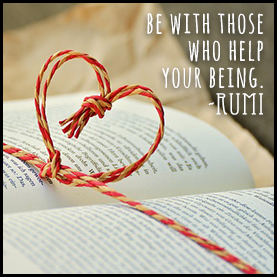 Rumi is a 13th century Persian poet who has captivated the minds and touched the hearts of the modern day Enneagram community, among others. In this 3rd blog of the series, the focus is on Enneagram type Two, using the Rumi poem to the left.
Rumi is a 13th century Persian poet who has captivated the minds and touched the hearts of the modern day Enneagram community, among others. In this 3rd blog of the series, the focus is on Enneagram type Two, using the Rumi poem to the left.
As for all of the Rumi poems in this series, the message, hopefully, speaks to all of us, no matter what our enneatype. This poem in particular highlights multiple subtle and not-so subtle core challenges for Enneagram Twos. And for me, it speaks to my personal journey and discoveries as a Two.
Let me start with the meaning of several words of this poem and then move to the poem as a whole. The poem begins with the word Be, and to really just Be in the presence of others is a big ask. As Twos, we are so accustomed to extending our energy to other people and the relationships we have with them, that to simply Be in ourselves and Be with others at the same time sounds nearly impossible. The Two conundrum: I am either in myself or I am with others, but how can I ‘Be’ in both simultaneously? This is reminiscent of Peter O’Hanrahan’s (a friend and Enneagram teacher) commentary that type Twos are caught in an inherent tension between autonomy and dependence; in the world of the Two, we are either autonomous and independent – or so we like to imagine ourselves – or we are terribly dependent on others, particularly their feelings toward us (which we hate to admit). So how can Twos simply Be with others? There is an answer, but it goes to the very core of the Two’s character structure.
The next significant word or phase is those who HELP your…. Twos perceive themselves as the people who help others, not the person who asks for or receives help, although many Twos secretly wish others would provide more assistance. But asking for help, if you are a Two, is a struggle and seldom happens. There are multiple reasons for this reluctance or inability to ask for help. First, Twos may not be aware of their needs, or at least not aware of them at a very conscious level. So if you don’t know you need something, you won’t ask for help or indicate you need anything. Second, the Twos’ attunement to the needs of others absorbs most of their focus, but it also lets Twos imagine they are not needy themselves and gives people the impression that Twos don’t need very much. Third, Twos focusing on others means limited attention to their own feelings, desires and aspirations. Finally, the self-image and self-perception of most Twos is that they don’t really need anything from others. Should a Two actually be in need or if someone offers assistance, the Two’s self-image gets challenged and rattled. What would it be like, if you are a Two, to contemplate truly receiving help from someone else? Would you really want this? Would you accept it were it offered? Would you and do you actually choose people – or even know how to choose people – to have in your life who would offer the kind of help to which Rumi refers? These questions should give Twos pause for reflection.
Your being is the last phrase in the poem and possibly the most poignant. What is the Being of the Two? What is our fundamental essence, our deepest core, our most profound inner space? Although this is difficult for all of us, no matter what our enneatype, it is especially powerful for the three enneatypes formed in the Heart Center: Twos, Threes, and Fours. These three types have much in common, one area being that we do not have a fundamental answer to the question Who Am I? To answer this question, the Heart Center types develop, albeit unconsciously, an image, one that’s used as a substitute for the true answer to the Who Am I? question. For Twos, the image is one of a kind, generous, thoughtful and loving person. Twos can hide behind this image with great agility, keeping them from having to confront the deeper issue: What is my true Being?
So what to do about this? Here are three simple actions: (1) spend real time with yourself and ponder the poem and its meaning, particularly how well you are able to Be inside you and also Be engaged with others; (2) ask yourself and honestly answer whether the people in your life truly support and help your Being and if not, why you keep them in close proximity or what you can do to change the nature of your relationships; and (3) reflect on whether you want to Be in a state of true Being.
Ginger Lapid-Bogda PhD, the author of five best-selling Enneagram-business books, is a speaker, consultant, trainer, and coach. She provides certification programs for professionals around the world who want to bring the Enneagram into organizations with high-impact business applications, and is past-president of the International Enneagram Association. Visit her website: TheEnneagramInBusiness.com. ginger@theenneagraminbusiness.com

Awesome article. Beautifully crafted. Thank you so much Ginger.
AliciaSPieterse Much appreciated! Glad it resonated with you as a Two also.